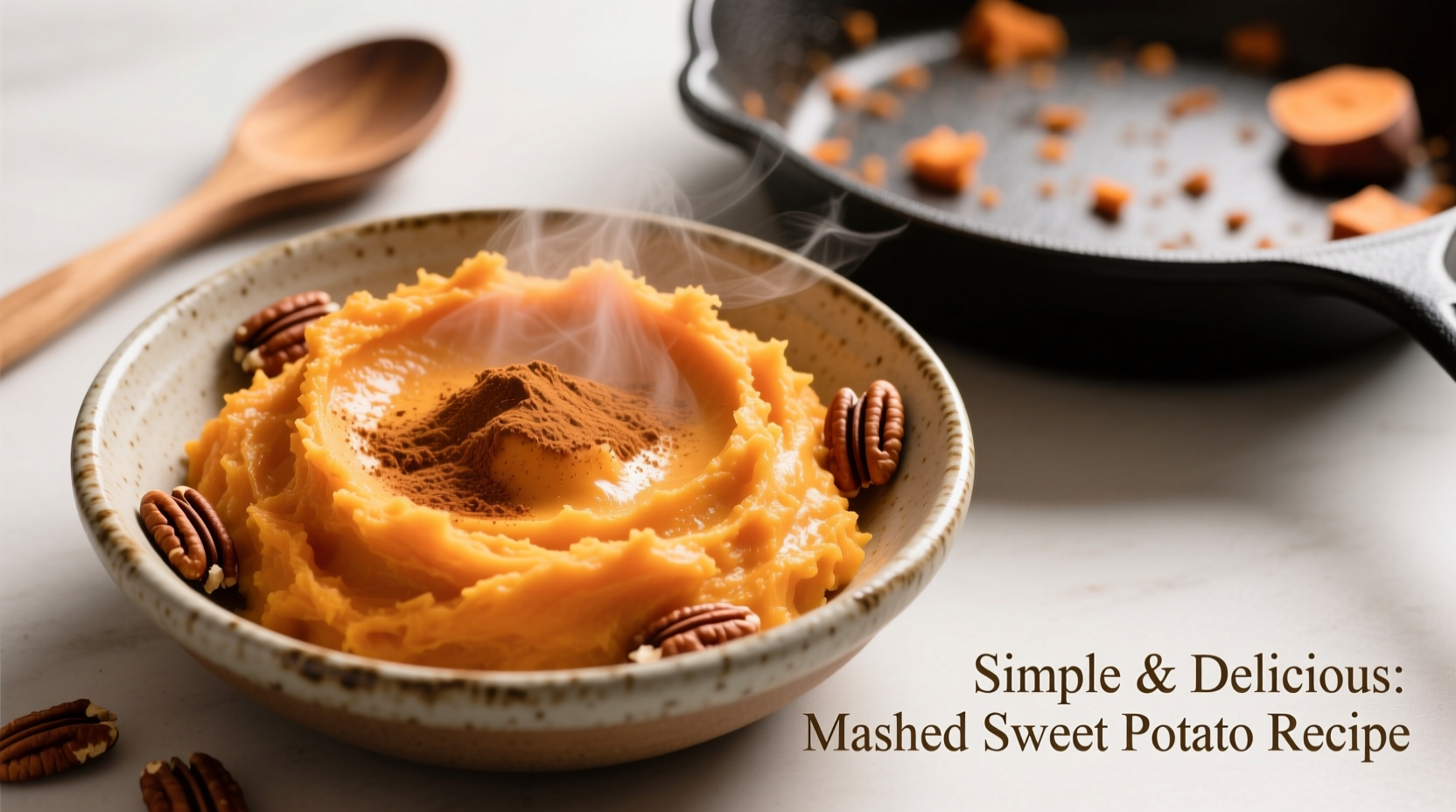There's nothing quite like creamy, flavorful mashed sweet potatoes—the ultimate comfort food that works equally well for weeknight dinners and holiday feasts. Unlike regular mashed potatoes, sweet potatoes bring natural sweetness and vibrant color to the table, but they require different handling to achieve that dreamy, lump-free texture without becoming watery or gluey.
The Science Behind Perfect Mashed Sweet Potatoes
Understanding the chemistry of sweet potatoes makes all the difference in your final dish. Sweet potatoes contain more moisture and less starch than regular potatoes, which affects how they behave when cooked and mashed. According to research from the USDA Agricultural Research Service, sweet potatoes reach optimal texture when cooked to an internal temperature of 205-210°F (96-99°C), allowing starches to fully gelatinize without breaking down the cell structure.
| Cooking Method | Texture Result | Best For |
|---|---|---|
| Boiling | Can become waterlogged | Quick preparation (with caution) |
| Steaming | Ideal moisture control | Most reliable method |
| Baking | Concentrated sweetness | Deep flavor development |
| Roasting | Caramelized edges | Complex flavor profiles |
Classic Creamy Mashed Sweet Potatoes (The Foolproof Base)
This foundational recipe delivers consistently smooth results with minimal ingredients. The key is controlling moisture content—sweet potatoes absorb water easily, which can ruin your texture.
What You'll Need
- 2 lbs (900g) orange-fleshed sweet potatoes (Garnet or Jewel varieties)
- 3 tbsp unsalted butter, room temperature
- 1/4 cup whole milk or half-and-half, warmed
- 1/2 tsp kosher salt
- 1/4 tsp freshly ground black pepper
Step-by-Step Instructions
- Prep properly: Peel sweet potatoes and cut into uniform 1.5-inch chunks. This ensures even cooking.
- Steam, don't boil: Place in a steamer basket over 1 inch of simmering water. Cover and steam for 20-25 minutes until fork-tender. Boiling adds too much moisture.
- Dry thoroughly: Spread cooked sweet potatoes on a baking sheet and let sit for 5 minutes to evaporate excess surface moisture.
- Warm dairy: Heat milk until just warm—not hot—to prevent curdling when mixed.
- Mash gently: Use a potato ricer or food mill for lump-free results. Avoid blenders or food processors which make sweet potatoes gluey.
- Season gradually: Add butter first, then warm milk a little at a time until desired consistency. Season with salt and pepper last.

4 Popular Flavor Variations Worth Trying
1. Southern-Style Brown Sugar & Pecan
Add 2 tbsp pure maple syrup, 1 tsp cinnamon, and 1/4 cup toasted pecans. Top with a sprinkle of flaky sea salt before serving. This variation honors the sweet potato's historical significance in Southern cuisine, where it became a staple crop after being introduced from Central and South America centuries ago.
2. Savory Herb & Garlic
Infuse 1/4 cup milk with 2 crushed garlic cloves and 2 sprigs fresh rosemary for 10 minutes. Strain and use this flavored milk in your base recipe. Stir in 2 tbsp chopped fresh chives before serving. This preparation aligns with FDA food safety guidelines that recommend cooking garlic in liquid rather than oil to prevent botulism risk.
3. Vegan Coconut Curry
Substitute coconut milk for dairy and add 1 tsp curry powder, 1/2 tsp turmeric, and a pinch of cayenne. The healthy fats in coconut milk help absorb the fat-soluble vitamins in sweet potatoes, enhancing their nutritional profile according to research from the USDA National Nutrient Database.
4. Maple Bacon & Thyme
Stir in 3 strips of finely chopped cooked bacon and 2 tbsp pure maple syrup. Finish with fresh thyme leaves. For food safety, the FDA recommends cooking bacon to an internal temperature of 145°F (63°C) with a 3-minute rest time.
Troubleshooting Common Problems
Even experienced cooks encounter issues with mashed sweet potatoes. Here's how to fix them:
Problem: Watery Texture
Solution: You likely boiled the potatoes or didn't dry them sufficiently after cooking. Next time, steam instead of boil, and spread cooked potatoes on a baking sheet for 5 minutes to evaporate excess moisture. If already watery, return to low heat and cook gently while stirring until excess liquid evaporates.
Problem: Gluey or Gummy Consistency
Solution: Over-mixing with a food processor or blender breaks down cell walls too much. Always use a potato masher, ricer, or food mill. If already gummy, the texture cannot be fixed—start over with fresh potatoes.
Problem: Lack of Flavor Depth
Solution: Sweet potatoes need proper seasoning. Always add salt gradually and taste as you go. Acid balances sweetness—try a squeeze of fresh orange juice or lemon zest. For richer flavor, substitute some liquid with roasted garlic puree or caramelized onions.
Serving Suggestions That Impress
Elevate your mashed sweet potatoes from simple side dish to centerpiece with these presentation tips:
- Texture contrast: Top with toasted pecans, pepitas, or crispy fried shallots
- Color pop: Garnish with fresh pomegranate seeds or microgreens
- Flavor bridge: Pair with proteins that complement sweet notes—pork tenderloin, roasted chicken, or blackened salmon
- Make ahead: Prepare up to 2 days in advance and store covered in the refrigerator. Reheat gently with a splash of milk to restore creaminess.
Storage & Reheating Guidelines
Proper storage maintains both safety and quality. According to the USDA Food Safety and Inspection Service, cooked sweet potatoes should be cooled within 2 hours and stored in airtight containers for up to 4 days. For best reheating results:
- Stovetop: Gently warm over low heat with 1-2 tbsp liquid, stirring frequently
- Oven: Cover with foil and bake at 325°F (163°C) until heated through
- Avoid microwave: Can create uneven heating and rubbery texture
Why These Techniques Work
Professional kitchens achieve perfect mashed sweet potatoes through precise moisture control and gentle handling. Unlike regular potatoes, sweet potatoes contain more sugar and less starch, requiring different treatment. The steaming method preserves flavor compounds that boiling would leach into water, while the gradual addition of warm dairy prevents temperature shock that can make potatoes gummy. These evidence-based techniques deliver consistent results whether you're cooking for two or twenty.











 浙公网安备
33010002000092号
浙公网安备
33010002000092号 浙B2-20120091-4
浙B2-20120091-4